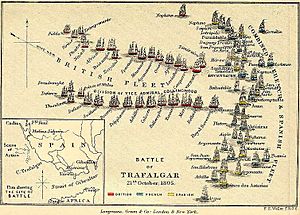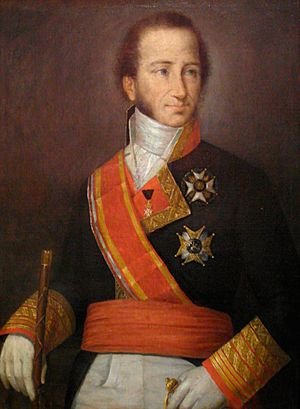Spanish ship Neptuno (1795) facts for kids

The Spanish ship Neptuno (1795)
|
|
Quick facts for kids History |
|
|---|---|
| Name | Neptuno |
| Ordered | 3 November 1792 |
| Builder | Royal Dockyard, Ferrol |
| Launched | 26 November 1795 |
| Fate | Wrecked, 23 October 1805 |
| Notes | Fought in the Battle of Trafalgar |
| General characteristics | |
| Class and type | 80-gun Neptuno-class ship of the line |
| Length |
|
| Beam | 49 ft 4 in (15.04 m) |
| Draught |
|
| Complement | 715 sailors |
| Armament |
|
The Neptuno was a powerful warship with 80 guns, part of the Spanish Navy. She was built in 1795. This ship played a role in the French Revolutionary Wars and Napoleonic Wars. She fought alongside French and Spanish ships in the famous Battle of Trafalgar. Sadly, she was badly damaged and wrecked after the battle.
Neptuno was built in Ferrol and launched in 1795. She was ready for service in time to help with a plan to invade England. However, the Spanish fleet was stopped by a British fleet. Neptuno did not join the fight at the Battle of Cape St Vincent. She had been sent to port before the battle began.
Years later, Neptuno was in a Spanish port. A combined French and Spanish fleet arrived there. This fleet had sailed to the West Indies and back. It had also fought the British in the Battle of Cape Finisterre. Neptuno joined this fleet. They tried to reach Brest, but the plan failed. Neptuno and the rest of the fleet ended up trapped in Cadiz. A British fleet led by Lord Nelson was blocking them.
In late 1805, the French admiral decided to leave Cadiz. Nelson's fleet met them in the important Battle of Trafalgar on October 21. Neptuno was at the front of the battle line. She was first separated from the main fighting. Later, she tried to help the admiral's ship. But she became trapped and fought two British ships. After more than an hour, she surrendered. A British crew took control of her.
Two days later, some Spanish ships that had escaped the battle came back. They managed to retake Neptuno. She was being towed to a friendly port. But she was already badly damaged. A strong storm hit the area, and Neptuno ran aground. Her crew was rescued, but the ship broke apart in the rough seas.
Contents
Building the Neptuno
Neptuno was built at the Royal Dockyard in Ferrol. She was the first ship of her kind, called the Neptuno-class. These 80-gun ships were designed by Julián Martín de Retamosa. He had also designed the 74-gun Montañés in 1794.
Neptuno's sister ship was the Argonauta. She was launched in 1798. Argonauta also fought alongside Neptuno at Trafalgar. When first built, Neptuno had many cannons. She had thirty 24-pounder guns on her lower deck. She also had thirty-two 18-pounders on her upper deck. There were twelve 8-pounders on her quarterdeck. Six more 8-pounders were on her forecastle.
By 1805, Neptuno had even bigger guns. Her lower deck guns were changed to 36-pounders. The upper deck guns became 24-pounders. More guns were added to her quarterdeck and forecastle. She ended up with 92 main guns. She also had some smaller cannons called carronades and obuses.
Julián Martín de Retamosa oversaw all the work on the Neptuno-class ships. Neptuno was launched in Ferrol in 1795. After launching, she spent 1796 being fitted out and tested at sea. Then, she joined the Spanish Mediterranean fleet. This fleet was based at Cartagena. Soon after, Spain became an ally of Republican France. They entered the French Revolutionary Wars against Britain. The Spanish Navy was ordered to help with a plan to invade Britain.
Joining Forces with France
On February 1, 1797, Neptuno sailed with the rest of the Spanish fleet. There were 27 large warships and many smaller ones. They sailed from Cartagena and passed through the Strait of Gibraltar. The fleet had orders to deliver gunboats to Algeciras. These gunboats would help attack Gibraltar. They also needed to protect a convoy of ships carrying mercury to Cadiz. After that, they were to sail to Brest to meet the French fleet.
The first part of the plan went well. Neptuno was sent with two other ships to take the gunboats to Algeciras. Neptuno stayed at Algeciras. Strong winds stopped the main Spanish fleet from reaching Cadiz. Their ships were scattered. On February 14, a British fleet found them near Cape St Vincent. Neptuno did not take part in the battle that followed. The Spanish fleet was defeated.
Leading to Trafalgar

By 1805, Neptuno was based in Ferrol. Her commander was Captain Don Cayetano Valdés y Flores. In late July, the combined French and Spanish fleet arrived in Ferrol. This fleet was led by Vice-Admiral Pierre-Charles Villeneuve. They had just returned from the West Indies. They had avoided a British fleet led by Lord Nelson there. But they had not attacked any British colonies.
Nelson had chased them across the Atlantic. Another British fleet had met them near Cape Finisterre. In a confusing fight, the British captured two of Villeneuve's ships. Villeneuve then went to Ferrol and Corunna. He sailed again on August 9. He took the Spanish ships he found there, including Neptuno. He hoped to meet another French fleet. But the meeting failed. The two French fleets thought each other were British ships. They tried to escape from each other. Villeneuve then fled to Cádiz.
The combined fleet stayed in Cadiz for several months. Nelson's British fleet was watching them. In mid-October, Villeneuve decided to sail out. Captain Valdés prepared Neptuno for sea. The fleet left Cadiz on October 19. Neptuno was at the very back of the fleet at first. But as the British approached on October 21, Villeneuve changed his battle line. Neptuno became the lead ship at the front. She was ahead of the French ship Scipion. She was part of a group of ships led by Rear-Admiral Pierre Dumanoir le Pelley.
The Battle of Trafalgar
At the start of the battle, the British attacked the middle and back of the combined fleet. Neptuno was left alone at first. She was ordered to stay close to the wind. This would allow other ships to get into position. The British ship HMS Africa fired at Neptuno. Africa had arrived late and sailed along the line. Her long-range shots did little damage.
At 2 PM, Admiral Dumanoir turned his ships around. They headed south to help the ships in the middle. He tried to fight his way to Villeneuve's main ship, the Bucentaure. With Dumanoir were Neptuno and four French ships. Neptuno fought her way towards Bucentaure. Captain Valdés hoped to use her small boats to recapture the admiral's ship. But he found the boats had been destroyed by gunfire.
Neptuno soon got into trouble herself. At 4 PM, she was cut off by two British ships. These were the HMS Minotaur and HMS Spartiate. Neptuno fought both ships for the next hour. Her mizzen mast was shot away. Her ropes and sails were badly damaged. Captain Valdés had already been wounded twice. He was hit again by falling pieces from the mast. He lost consciousness and was taken below. His second-in-command, Joaquín Somoza, took over.
After an hour, Neptuno lost more masts. Somoza was also wounded. First Lieutenant Antonio Miranda took command. Neptuno surrendered at 5:10 PM. She was the last ship of the combined fleet to give up. Her casualties were not too high. About 38 to 42 sailors died, and 42 to 47 were wounded. A group of 48 British sailors from Minotaur boarded Neptuno. They took control of the ship. First Lieutenant Miranda gave his sword to the British captain.
The Storm and Wreck
The next day, Minotaur began towing Neptuno. But a storm began to rise. The towline broke, and Neptuno was in danger of hitting the shore. On October 22, her mainmast fell down. It crashed through the captain's cabins. A Spanish paymaster and one British sailor were killed. Now, Neptuno had no masts at all. The crew tried to fix the decks and put up temporary sails.
On October 23, some French and Spanish ships that had escaped Cadiz came out. They wanted to retake some of the captured ships. The British ships let go of some of their captured ships. They formed a defensive line. While some French frigates bothered the British, the French frigate Hermione took Neptuno in tow. The Spanish crew on Neptuno then rose up and took back their ship. The British prize crew were sent to work the pumps. Neptuno dropped anchor in Cadiz Bay.
During the night, the storm grew stronger. Neptuno's anchors dragged, and she ran aground. Ropes were quickly passed between the ship and the shore. Rafts were built to rescue the men. One raft made several trips. But it then flipped over, and several men drowned. Over the next few days, the remaining men were rescued. This included the wounded Captain Valdés. They were taken off by rafts and fishing boats.
The abandoned Neptuno was soon smashed to pieces by the heavy seas. About 20 men were lost when she wrecked. Neptuno was not the only ship lost. Many captured British ships were sunk or wrecked. Several ships that had come out from Cadiz were also lost.
The remaining French ships were trapped in Cadiz. The Spanish took them into their navy in 1808. One of these ships was an 80-gun French ship also named Neptune. The Spanish renamed her Neptuno. She served with the Spanish Navy until 1820.
Images for kids
-
Portrait of Cayetano Valdés y Flores, commander of Neptuno at Trafalgar, painted by José Roldán y Martínez, Sevilla, 1847
See also
 In Spanish: Neptuno (1795) para niños
In Spanish: Neptuno (1795) para niños



